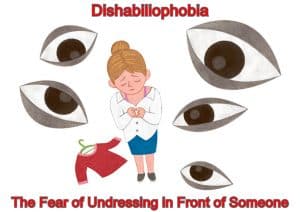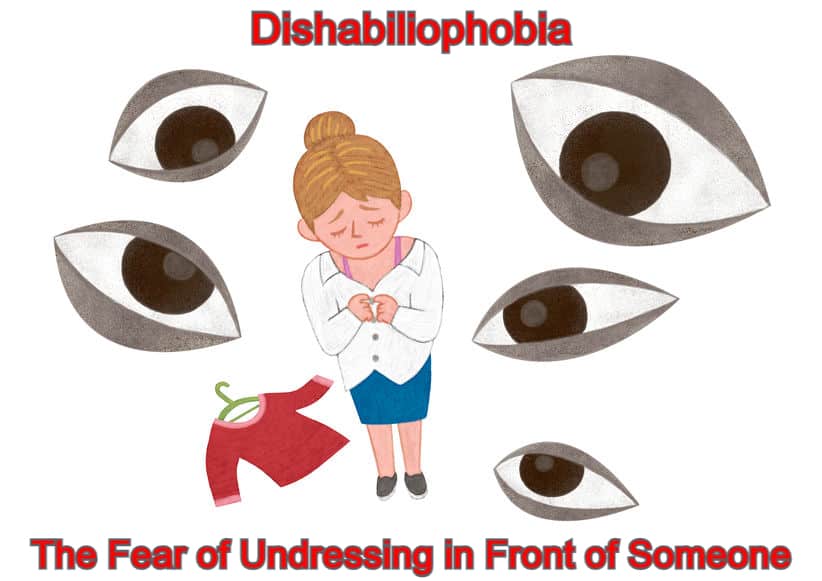Share This Article
Dishabiliophobia: More than Shyness
Are you afraid of undressing in front of others, even if it’s someone you’re in a relationship with?
Do you have the same paralyzing fear of undressing even when no one is watching? It’s likely your chest feels tight at the thought of undressing. You may even have panic attacks when you think about it.
If the mere thought of undressing for a shower grips you with terror, you may have dishabiliophobia.
It may seem impossible to you right now, but there is help available for your fear. Dishabiliophobia can be managed. The first step is to learn more about what you’re going through.

What Is Dishabiliophobia?
Before we go further, let’s first understand what this phobia is. Understanding the problem will help you better manage it.
So, what does dishabiliophobia mean? Dishabiliophobia is an intense and irrational fear of undressing in front of someone. Not many know about this phobia and some don’t even consider it to be a valid fear, but it is very real to those who suffer from it.
Individuals who have this phobia may experience intense and painful bouts of panic and anxiety. Even the thought of undressing—with or without someone present—is enough to induce stress.
What Are the Causes of Dishabiliophobia?
There isn’t one particular cause for dishabiliophobia. The most common dishabiliophobia causes are environmental factors and genetics. If you come from a family that has a history of panic disorders or phobias, then it’s possible you inherited this phobia.
Traumatic events are another common cause for developing dishabiliophobia. For example, you may have been subject to intense humiliation and body shaming when you were undressing.
You could have also developed tendencies to body-shame yourself and have low self-confidence. These traumatic experiences and situations can alter one’s state of mind and evolve into a phobia.
Symptoms of Dishabiliophobia
Symptoms of dishabiliophobia are different for each individual, but there are some common ones. Panic attacks and anxiety attacks are two of those. However, some identifiable symptoms are specific to dishabiliophobia.
Mental/Emotional Symptoms
- Intense fear of losing control
- Constant feeling of dread
- Worry of dying
- Intense guilt, embarrassment, and blaming yourself
- Cutting yourself off from others
- Feeling worthless or sad
- Inability to focus on anything
- Continuous bouts of anger and irritation
- Intense panic and anxiety
Physical Symptoms
- Shaking
- Profuse sweating
- Chills
- Accelerated heartbeat
- Feeling like someone’s choking you
- Difficulty breathing
- Discomfort in the chest
- Nausea
- Dry mouth
- Elevated blood pressure
- Headaches
- Feeling dizzy
Self-Help: What Can I Do to Overcome Dishabiliophobia?
At first, it may seem impossible to overcome your fear, but it is possible. The first step is to acknowledge your fear. Once you’ve acknowledged your fear, you can move on towards healing. Read on for ways you can deal with dishabiliophobia.
Surround Yourself with Encouraging People
This may seem like an overly simple way of dealing with what feels like a complicated problem, but it is an important step. People who are empathetic, encouraging, and loving can impact your self-journey positively. Having friends who can listen can help make the healing process easier. Supportive people can boost your morale and mental health. This can help you feel safe, protected, and loved.
Educate Yourself
Educate yourself about what you’re going through. Understand as many aspects of your phobia as possible. There are several websites and books you can study to understand your phobia.
Exercise
It may be difficult to engage in any sort of activity at a time like this, but exercise has been known to benefit the mind and body. Cardiovascular exercises are known to relieve panic, stress, and anxiety. Of course, weight training and other exercises are also beneficial, but cardio has been proven to release more endorphins or happy hormones in the body.
Cardiovascular exercises are also widely popular because of how easy and accessible they are. You don’t need any extra equipment to do cardio. Running, cycling, jumping rope, and swimming are all forms of cardio. You can also try playing some sort of sport like basketball, football, squash, or soccer.
Don’t Overthink
Another thing to understand is that overthinking will only make your situation worse. Overthinking can ruin your entire process and render you helpless. If you feel like you’re overthinking, write down your thoughts or talk to people you trust. This will help you clear your mind and put things in perspective.
Seek Professional Help
It’s possible that the above-mentioned self-help techniques haven’t worked for you. That’s okay and you don’t have to feel ashamed. There are trained professionals who can help with your dishabiliophobia treatment.
Mindfulness Therapy
Mindfulness therapy is helpful for people who suffer from anxiety, stress, depression, and low self-confidence. Mindfulness therapy helps patients focus on things that have little to no emotional baggage. Therapists help patients accept their flaws and live in the present moment. One of the easiest methods of doing this is by focusing directly on breathing. This helps patients stay calm and in control of their thoughts.
Exposure Therapy
Exposure therapy is one of the most effective and helpful methods of therapy for individuals suffering from phobias or anxieties. This method involves the therapist slowly bringing out the fears of the patient so that they can deal with them directly. In the case of dishabiliophobia, the therapist may ask the patient to undress in a place where he/she is comfortable alone. The patient is asked to watch themselves as they undress. This method helps in building confidence and self-esteem.
Cognitive Behavioral Therapy
Cognitive behavioral therapy, or CBT, is a method of therapy that involves exposing your fears and anxiety to create positive thought processes. This improves the way the patient thinks and feels in certain situations while improving overall mental health. CBT is known to benefit people who have recently started suffering from dishabiliophobia. However, if the phobia has been induced because of a traumatic event from the past, CBT may not be as effective and additional therapies may be required.
How to Avoid Dishabiliophobia
The first step to avoiding this phobia is to face your fears. If you’re scared of undressing in front of someone or when you’re alone, try and understand why this is happening. Once you know the reason for your fear, work towards overcoming it. Reach out for help or employ self-help methods. Most importantly, try not to overthink the situation.
In Conclusion
It isn’t out of the ordinary to be afraid of things and situations. If your phobia is beginning to consume you and preventing you from having a normal life, get help and confide in someone you trust. It may seem difficult, but you can overcome your dishabiliophobia.
Determination and patience go a long way in helping you get over your fear. At the same time, surround yourself with people who can support you in your journey. It may be a slow process, but in time you will overcome this phobia and go back to enjoying the normal life you crave.




